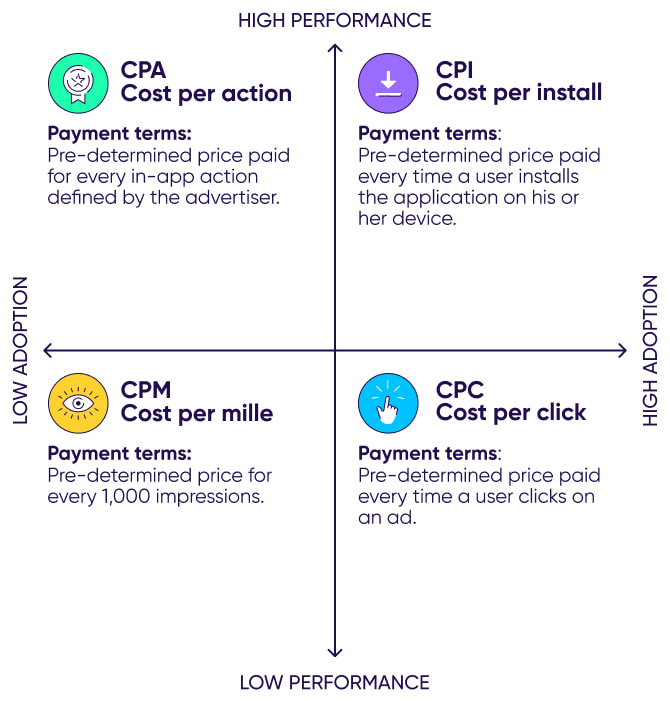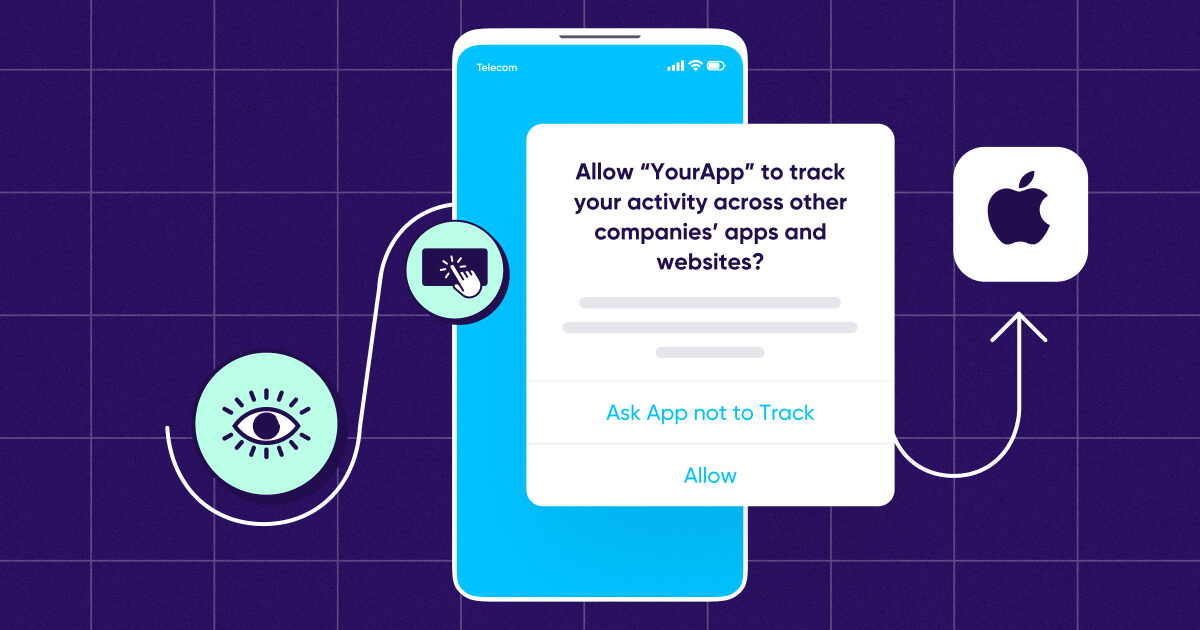
Cost per action (CPA)
Cost per action (CPA) is a pricing model in which marketers pay ad networks or media sources when a user takes a particular action (such as completing a purchase or registration) inside of an app, after engagement with an ad. It’s calculated by dividing the advertising cost by the number of actions taken.
What is cost per action?
CPA, or cost per action, is a pricing model used in mobile advertising in which marketers pay media sources when a user takes a specific action within the app.
That action can be any in-app event — a registration, tutorial completion, or purchase, for example — that is driven by a particular source. The price the advertiser pays for an action completion is fixed at the start.
Tracking your CPA is a good way to measure the effectiveness of a given campaign or media source.
Why is CPA important?
CPA has become an increasingly important part of the mobile marketer’s toolkit. Its main appeal is that it’s a pure performance model that lets marketers pay only for what they really want, rather than wasting budget on passive views that don’t convert.
It’s also great for attribution, as you can clearly see which sources lead directly to valuable actions — helping you make more informed campaign decisions down the line.
When you’re tracking your campaign KPIs (key performance indicators), CPA is valuable as it shines a light further down the funnel than metrics relating to views or clicks. By this point, you’ve already persuaded users to install your app — the big question is, are they engaging in a way that brings in revenue?
Finally, CPA benefits media sources, as it tends to attract high-performance marketers who want to know where every cent is going.
That said, the risk in this model sits largely with the media source or ad network, as they have to pay for the ad space upfront before conversions bring the money rolling in from the advertiser. For this reason, CPA is offered less frequently than other pricing models.
How to calculate cost per action – CPA formula
You can calculate your CPA using the following formula:
CPA = total advertising cost in period X / number of desired actions in time period X
Let’s say your freemium fitness app offers some basic workouts for free, with the option to buy a monthly subscription for customized training plans. To encourage free users to upgrade to paid membership, you offer them a seven-day subscription trial: the goal is for them to enter their registration data.
If you spend $1,000 advertising the trial, and 200 people sign up, your CPA is:
$1000 / 200 = $5
CPA vs other KPIs
CPA shares similarities with other mobile marketing models, which are used at different points along the funnel. Let’s untangle some of the acronyms:
CPA vs eCPA
Your eCPA, or effective cost per action, is similar to CPA but offers a broader look at how a given ad network is performing. eCPA includes any and all campaign CPAs you wish to measure, giving you an overall picture of advertising costs on that media source over time.
It’s calculated by dividing the total cost incurred from that network by the total number of specified actions in a set timeframe.

CPA vs CPM
CPM stands for cost per mille, meaning the cost a marketer pays an ad network for a thousand impressions of their ad. This is useful in scaling campaigns and measuring brand awareness, but doesn’t translate to profitability like CPA does.
CPA vs CPC
With CPC, or cost per click, advertisers pay when a user clicks on a particular ad. This is a step up from impressions in showing genuine engagement with an ad, but still doesn’t guarantee monetization. Audiences may be intrigued enough to visit your homepage or app store page, but go no further.
CPA vs CPI
When your goal is user acquisition, CPI is your metric of choice: as an advertiser, you only pay only when your ad directly results in an app install. However, it’s likely that only a small proportion of installers will go on to generate revenue through ads or purchases. That’s why CPA looks beyond the install to show how users behave inside your app.
What is a good CPA?
There’s no set figure for what makes a good CPA — it very much depends on your business and your campaign goals. What you need to remember is that the action must be worth the cost.
For example, in our content-driven world, social media shares are popular goals. If a user shares your content thanks to a particular ad, you’ll pay — but the share in itself doesn’t bring in revenue. You’ll need to figure out its own value in building awareness or driving installs.
That’s why you should look at CPA in conjunction with monetization KPIs, like lifetime value and ARPU, to make sure the customers you’re working to acquire and engage are actually profitable.
How can you lower your CPA?
We’ve seen there’s no “right” CPA, but hopefully you’ve worked out that lower is better. This model can be relatively expensive, so here are five ways to bring your CPA down and prevent it from eating up your whole marketing budget.
Reach the right audience
When you segment your audience carefully, and offer something that truly brings them value, you’re more likely to achieve conversions. And the more actions they take, the lower the cost for each one.
Improve your creative
Be sure to grab users’ attention and include a clear call to action (CTA), so there’s no mistaking what you want them to do and why they’ll benefit. For example, if you want people to subscribe to your meditation app, your CTA could read “Feel calmer today” rather than a generic “Sign up now”.
Raise your ad quality score
Dig deeper into your paid search campaigns to make sure your search results have maximum relevance for your audience. Check you’re using the most relevant keywords, excluding negative ones, and aligning ad messaging with your app experience to attract the highest-quality users.
Choose your goals wisely
The beauty of CPA is that you’re in control of the “A” — the action can be anything you want it to be. So make it count. Due to the high cost of this strategy, some brands reserve it for revenue-generating actions, focusing on sales campaigns rather than awareness or data-gathering.
Protect yourself from fraud
CPA fraud sees criminals faking in-app activity so they get the payout from the advertiser. Investing in a comprehensive fraud protection solution for your mobile ad campaigns — like the one offered by AppsFlyer — will stop your budget falling into the wrong hands.
CPA and the mobile ecosystem
Given the higher costs and lower availability of CPA, most marketers tend to operate on a CPC or CPI basis. However, it’s always worth keeping track of your eCPA to help focus your campaigns and ad networks on the most profitable users.
While CPA may not be right for everyone, it guides both performance-driven marketers and media sources to focus on the quality of their users, and deliver more sustainable results in the long run.
Key takeaways
- CPA (cost per action) is a mobile marketing model where the advertiser pays the media source a set fee every time a user completes a particular action after engaging with an ad. It’s calculated by dividing ad spend by the number of completed actions.
- CPA attracts high-performance marketers, but is riskier for ad networks. This means it’s more expensive and less commonly offered than other models.
- Whereas CPA focuses on in-app events, other pricing models are used higher up the marketing funnel, including cost per mille, cost per click, and cost per install. eCPA provides a broader picture of an ad network’s performance over time.
- A good CPA depends on your business and goals, but the actions you pay for should always be profitable.
- To lower your CPA, you need to reach the right audience with the most engaging and relevant message. The strategy is best suited to revenue-generating campaigns — but fraudsters know this too, so invest in a protection solution.
- Within the mobile marketing ecosystem, CPA drives a focus on high-quality users and sustainable results.



